
Set 1 of My
Timber Harvesting (Logging) Photographs
Bob Jensen at
Trinity University
We live in
Sugar Hill, New Hampshire which got its name for the tapping of maple trees to
get
maple syrup, maple sugar, maple flavorings, and sweet maple paste.
Normally this
time of year in early April I do a special on maple sugaring in Sugar Hill
---
http://www.trinity.edu/rjensen/Tidbits/Trees/Maple/Maples01.htm
Or I do a special on April wildflowers of Texas where I lived for 24 years in San Antonio
Texas Wildflowers Set 1 --- http://www.trinity.edu/rjensen/tidbits/Wildflowers/Texas/WildflowersTexas.htm
Texas Wildflowers Set 3 --- http://www.trinity.edu/rjensen/Tidbits/Wildflowers/Texas02/TexasWildflowersSet02.htm
But this year
I don't have enough new photographs for either one of the above themes
And so I will do a special on timber harvesting
I have new photographs of timber harvesting since a timber harvesting company
cleared 20 acres
a few weeks ago while I watched from my desk
The owner of
24 acres in front of our cottage had his timber cut to raise money for taxes
For us this merely improved our already magnificent views of three mountain
ranges in the White Mountains
My neighbors and I are now working to buy this land to put it into the
Ammonoosuc Conservation Trust
The golf course behind our cottage has already been put into this conservation
trust
You can see some of the timber that was harvested in the picture taken through
the window in front of my desk


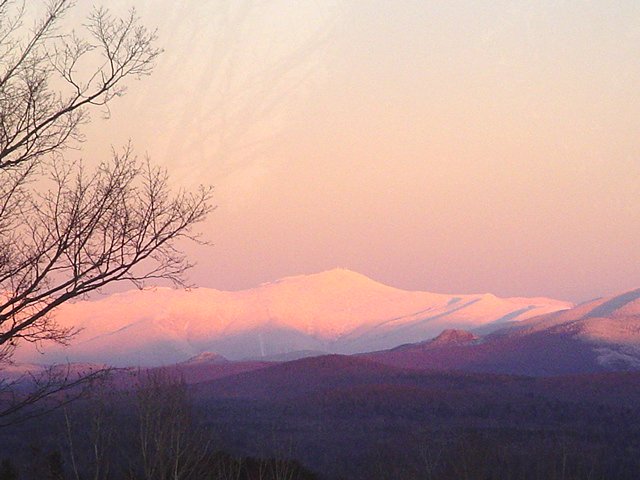

Below is the view from my desk about
ten days later
Just before the loggers cleaned up the remaining trees on the ground
The clear-cutting made it look a bit more like a park
But the stumps are still in the ground since nothing yet has been planned for
use of this land
Timber Harvesting --- http://en.wikipedia.org/wiki/Timber_harvesting
Logging is the cutting, skidding, on-site processing, and loading of trees or logs onto trucks[1] or skeleton cars.
In forestry, the term logging is sometimes used in a narrow sense concerning the logistics of moving wood from the stump to somewhere outside the forest, usually a sawmill or a lumber yard. However, in common usage, the term may be used to indicate a range of forestry or silviculture activities.
Illegal logging refers to what in forestry might be called timber theft.[2][3] It can also refer to the harvest, transportation, purchase or sale of timber in violation of laws. The harvesting procedure itself may be illegal, including using corrupt means to gain access to forests; extraction without permission or from a protected area; the cutting of protected species; or the extraction of timber in excess of agreed limits.[4]
Clearcut logging is not necessarily considered a type of logging but a harvest or silviculture method and is simply called clearcutting or block cutting. In the forest products industry logging companies may be referred to as logging contractors, with the smaller, non-union crews referred to as "gyppo loggers."
Cutting trees with the highest value and leaving those with lower value, often diseased or malformed trees, is referred to as high grading. It is sometimes called selective logging, and confused with selection cutting, the practice of managing stands by harvesting a proportion of trees.[5]
Logging usually refers to above-ground forestry logging. Submerged forests exist on land that has been flooded by damming to create reservoirs. Such trees are logged using underwater logging or by the lowering of the reservoirs in question. Ootsa Lake and Williston Lake in British Columbia, Canada, are notable examples where timber recovery has been needed to remove inundated forests
Jensen Comment
I watched about $4 million in heavy logging machinery work across the road. It's
fascinating to watch how about an acre
of mature trees can be toppled in roughly one hour. The plan is the clear cut
about 30 acres. My views across the valley will be improved, but there will
be less color in front of my desk during foliage season. I do not own this land,
but we are working to get the land put into a conservatory like the golf course
behind our cottage has been put into a perpetual conservatory.
Here's how the clear cutting operation works. I don't think the timber
removal operators even own a chain saw.
Humongous machines with giant tires (wrapped in snow chains) carry whole trees
up to an enormous chipping machine in front of my driveway. Trucks as large as
the law allows back up to the chute on the chipping machine. Roughly 2-10 at
a time whole trees are lifted by a crane into the other end of the chipping
machine. It takes about 40 minutes to fill each 18-wheel truck. The chips are
then carried away to mills that manufacture things like wood stove pellets,
electric power, and plywood. On this job all those big trucks of chips are being
taken to Pine Tree Power as biofuel for the generation of electric power. I did
not check it out, but this type of fuel may not be allowed in California due to
air pollution.
The timber harvesting companies are not making as much money these days since
most of our pulp and paper mills have been shut down for good.
The larger logs (over a foot in diameter) are cut into 15-foot lengths and
stacked onto open trailers. These are hauled off to lumber mills that
manufacture construction lumber and/or hardwood veneer.
I suspect all this heavy equipment will be trucked away in less than a week.
The hardest things to get rid of are stumps. Since this land is not being
developed for anything, the stumps will probably remain. If they were to be
removed, giant Caterpillars would be brought in to commence the slow process of
ripping the stumps out of the ground.
Trivia Question
Why do timber harvesting companies prefer the winter season?
Answer,
In winter the ground is frozen into concrete. None of their machines get bogged
down. In our thaw season (April-June) these timber harvesting companies shut
down up here. In summer they're back at it, but they can be bothered by wetlands
in the woods. Wetlands are less of a problem in the winter.
Below is one of the most expensive
machines hauled in to mill whole trees into chips

The chipping machine was set up
across from the end of our driveway
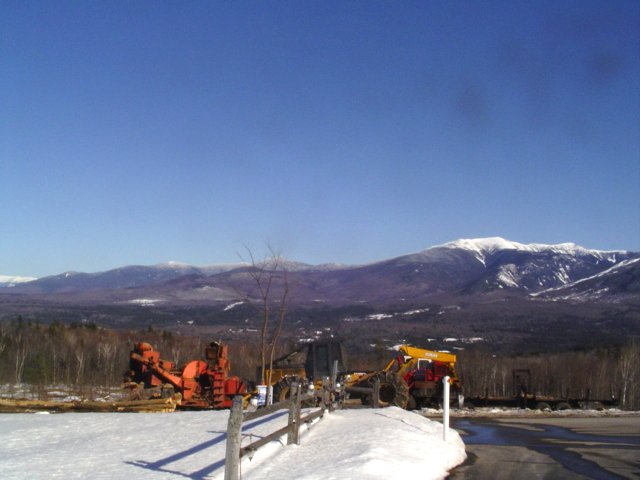

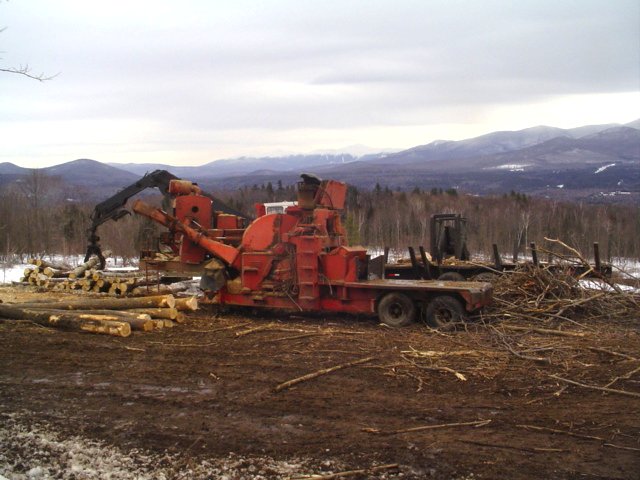
The chip chute fills this 18-wheel
truck trailer in about 40 minutes
The chips were then hauled to Pine Tree Power near Whitefield
The chips are used as a biofuel to generate electricity
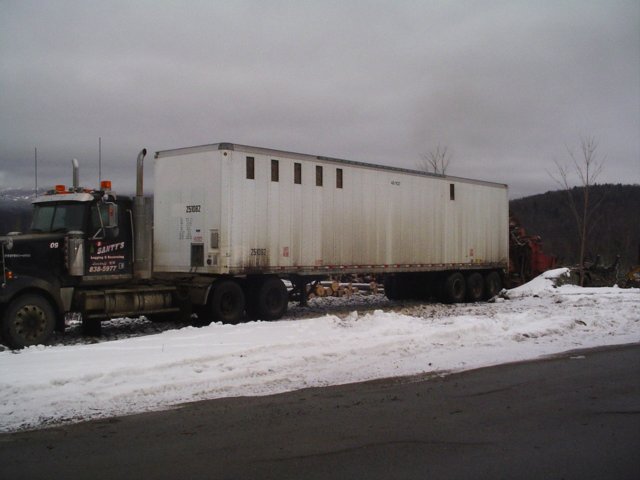
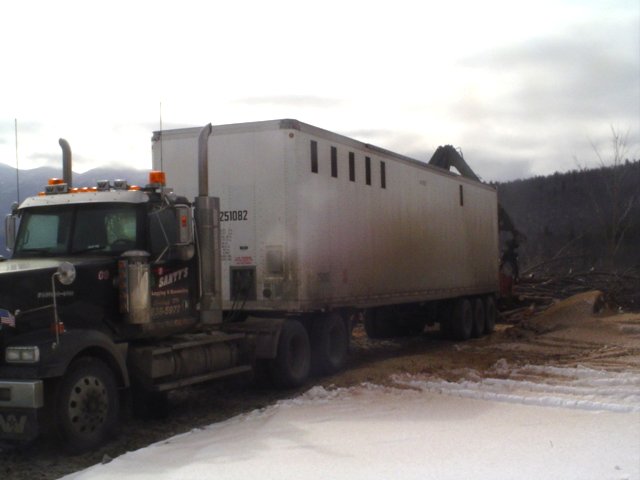
The guy on top of the chipper has
only one duty --- to stop the chipper if it jams
There was never a chipper jam on this job
So this guy just sat in the cold at watched several whole trees being fed into
the chipping machine
A stream of chips flies into the truck trailer like corn from a combine

Below you can see the trees being
fed into the front end of the chipping machine


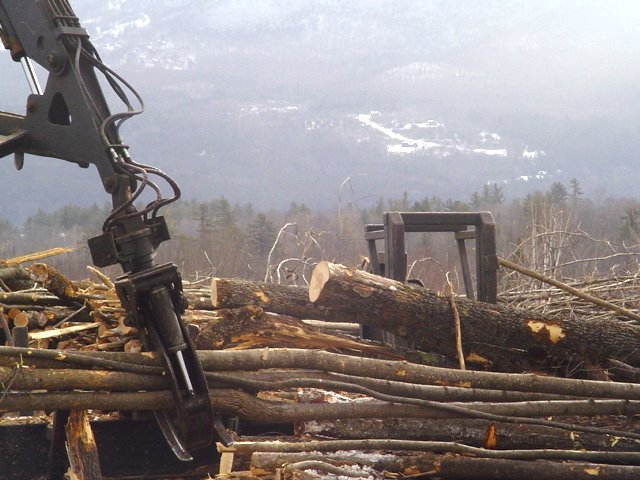

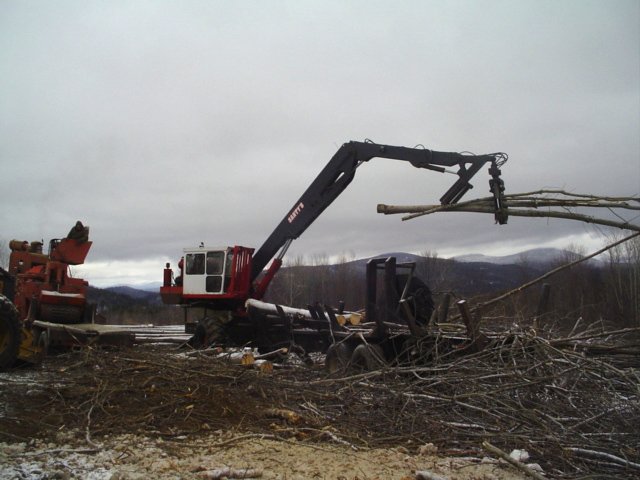

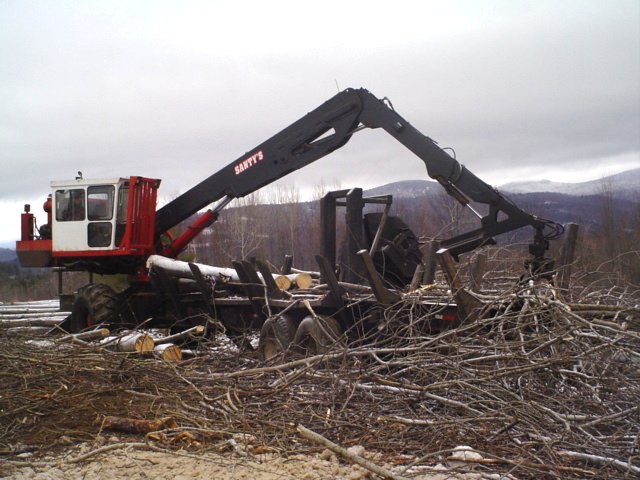
The larger logs are stacked until
being loaded onto a flat bed trailer
The loggers called this junk timber that they trucked to a wood lot near Lisbon
Where the logs are cut and split into firewood for homes

The loggers hauled in three skidding
machines like the one below
After the cutting machine cut the trees down below
These machines were used to skid the logs up beside the chipping machine

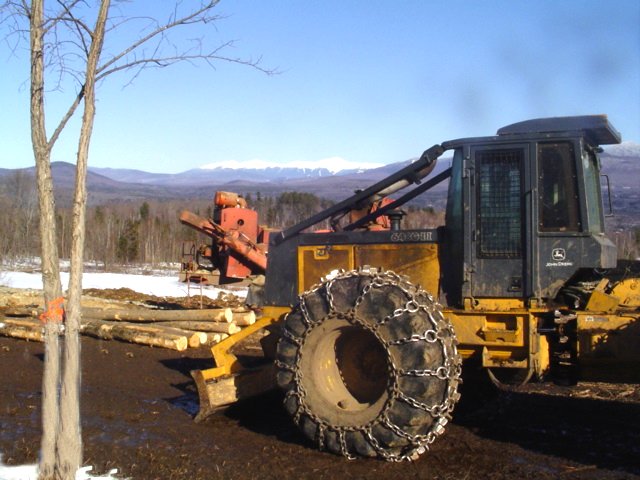

Down below the excavator down below
moved the trees into piles for the skidding machines
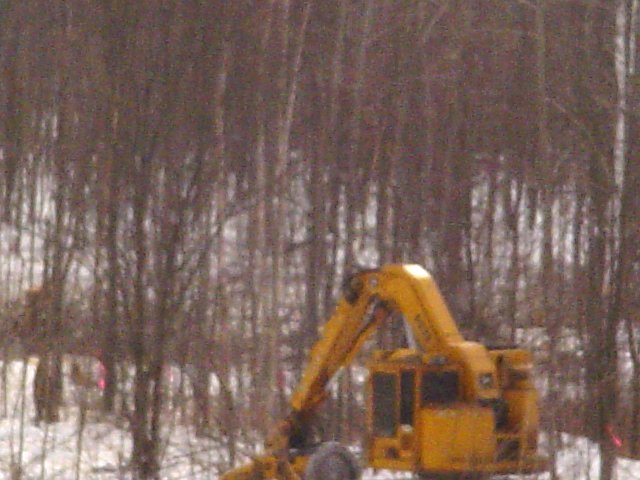
Loading up to move on to much bigger
jobs
The bearded face of the lumberjack
boss

And this is his license plate where
he lives free and does not wear a coat until it goes below zero
Maple Syrup --- http://en.wikipedia.org/wiki/Maple_syrup
Maple syrup is a syrup usually made from the xylem sap of sugar maple, red maple, or black maple trees, although it can also be made from other maple species. In cold climates, these trees store starch in their trunks and roots before the winter; the starch is then converted to sugar that rises in the sap in the spring. Maple trees can be tapped by boring holes into their trunks and collecting the exuded sap. The sap is processed by heating to evaporate much of the water, leaving the concentrated syrup.
Maple syrup was first collected and used by the indigenous peoples of North America. The practice was adopted by European settlers, who gradually improved production methods. Technological improvements in the 1970s further refined syrup processing. The Canadian province of Quebec is by far the largest producer, responsible for about three-quarters of the world's output; Canadian exports of maple syrup exceed C$145 million (approximately US$141 million) per year. Vermont is the largest producer in the United States, generating about 5.5 percent of the global supply.
Maple syrup is graded according to the Canada, United States, or Vermont scales based on its density and translucency. Sucrose is the most prevalent sugar in maple syrup. In Canada, syrups must be at least 66 percent sugar and be made exclusively from maple sap[1] to qualify as maple syrup. In the United States, a syrup must be made almost entirely from maple sap to be labeled as "maple".
Maple syrup is often eaten with pancakes, waffles, French toast, or oatmeal and porridge. It is also used as an ingredient in baking, and as a sweetener or flavoring agent. Culinary experts have praised its unique flavor, although the chemistry responsible is not fully understood.
Maple Tree --- http://en.wikipedia.org/wiki/Maple_tree
Maples are variously classified in a family of their own, the Aceraceae, or together with the Hippocastanaceae included in the family Sapindaceae. Modern classifications, including the Angiosperm Phylogeny Group system, favour inclusion in Sapindaceae. The type species of the genus is Acer pseudoplatanus (Sycamore maple).
There are approximately 128 species, most of which are native to Asia, with a number also appearing in Europe, northern Africa, and North America. Only one species, the poorly studied Acer laurinum, is native to the Southern Hemisphere. Fifty-four species of maples meet the International Union for Conservation of Nature criteria for being under threat of extinction in their native habitat.
The word Acer derives from a Latin word meaning "sharp" (compare "acerbic"), referring to the characteristic points on maple leaves. It was first applied to the genus by the French botanist Joseph Pitton de Tournefort in 1700. The earliest known fossil maple is Acer alaskense, from the Latest Paleocene of Alaska.
My Maple Tree and Maple Sugaring Favorite Photographs
http://www.trinity.edu/rjensen/Tidbits/Trees/Maple/Maples01.htm
More of Bob Jensen's Pictures and
Stories
http://www.trinity.edu/rjensen/Pictures.htm
Blogs of White
Mountain Hikers (many great photographs) ---
http://www.blogger.com/profile/02242409292439585691
.
White Mountain News --- http://www.whitemtnews.com/
On May 14,
2006 I retired from
Trinity University after a long and
wonderful career as an accounting professor in four universities. I was
generously granted "Emeritus" status by the Trustees of Trinity University. My
wife and I now live in a cottage in the White Mountains of New Hampshire ---
http://www.trinity.edu/rjensen/NHcottage/NHcottage.htm
Bob
Jensen's Blogs ---
http://www.trinity.edu/rjensen/JensenBlogs.htm
Current and past editions of my newsletter called New
Bookmarks ---
http://www.trinity.edu/rjensen/bookurl.htm
Current and past editions of my newsletter called
Tidbits ---
http://www.trinity.edu/rjensen/TidbitsDirectory.htm
Current and past editions of my newsletter called
Fraud Updates ---
http://www.trinity.edu/rjensen/FraudUpdates.htm
Bob Jensen's past presentations and lectures
---
http://www.trinity.edu/rjensen/resume.htm#Presentations
Our
address is 190 Sunset Hill Road, Sugar Hill, New Hampshire
Our cottage was known as the Brayton Cottage in the early 1900s
Sunset Hill is a ridge overlooking with
New Hampshire's White Mountains to the East
and Vermont's
Green Mountains to the West
New Hampshire Historical Society --- http://www.nhhistory.org
Clement Moran Photography
Collection (antique New Hampshire photographs) ---
Click Here
http://www.library.unh.edu/digital/islandora/solr/search/moran/1/category%3APhotographs~slsh~Clement%5C%20Moran%5C%20Collection%2A~/dismax
Bob Jensen's Threads --- http://www.trinity.edu/rjensen/threads.htm
Bob Jensen's Home Page --- http://www.trinity.edu/rjensen/